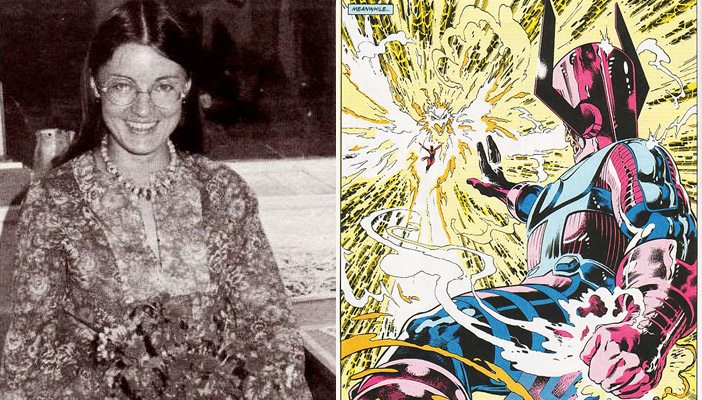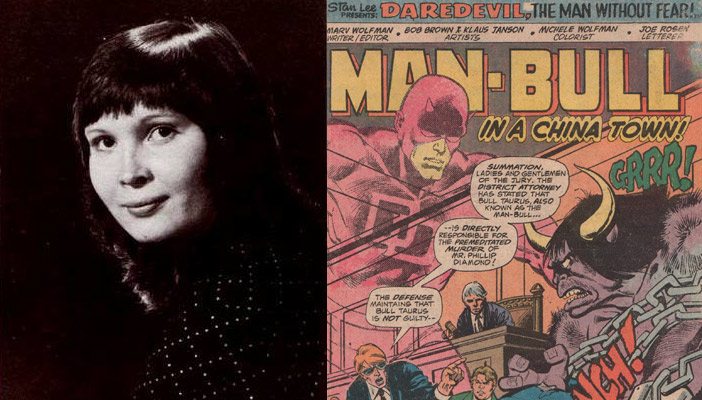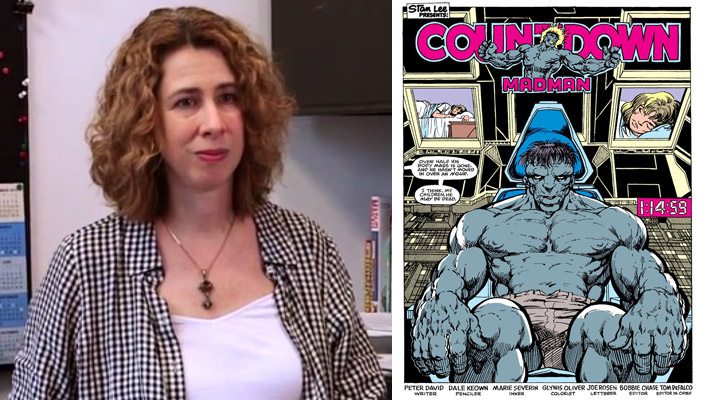In this day and age it’s likely that you’ll read a lot of articles about women who make comics. They’ll focus on great new titles like Monstress, Saga and Bitch Planet. Maybe they’ll even mention a book like Moon Knight, which features the incredible colours of Jordie Bellaire.
Though it’s wonderful that these books are getting the love that they deserve, these articles are often written as if women never have never been involved in comics in any capacity until the last few years, and that is not only incredibly annoying but also patently false. Women have been an active part of the comics industry since it’s inception, whether behind the scenes or queuing up at the newsstand, women have been there.
So here is a list of 13 amazing women who’ve been making comics longer than most of us have been alive. Women who are just as — if not more — important in the men who regularly become household names.
Letterers
Janice Chiang

One of the most prolific comic book letterers of all time, Janice Chiang has been lettering your favourite superheroes for over forty years. Beginning in the Marvel bullpen in the early 70s, her first lettering gig was on Conan The Barbarian. From there she went on to letter over a thousand comics — and that’s a very conservative estimate — including runs on Thor, Iron Man, Power Man and Iron Fist, Defenders, and The Avengers. Though it’s her iconic work on Ghost Rider (she designed his badass flaming word balloons), Alpha Flight, Rom, Transformers, and Visionaries that she is most well known for. Still creating wonderful letters in comics like DC Super Hero Girls and Riverdale, Janice is an active member of the lettering community. A trailblazer for women in comics and letterers everywhere, Janice Chiang’s impact on comics cannot be understated.
Ellie De Ville

England’s premiere letterer, there’s really no one like the multi-award winning Ellie De Ville. In the world of lettering it’s hard to find someone who’s had a career as consistent yet eclectic as Ellie (except maybe Janice Chiang!). Her work at 2000AD — almost five hundred issues — cemented her as one of the most talented and prolific talents in lettering. But even if you’re not into the British indie monolith, you’ve likely seen her letters in The Killing Joke. De Ville lettered the backup story from the now ubiquitous deluxe edition (the one in every Barnes and Noble in the country) of the book, one of the highest selling and most critically acclaimed collections of all time. Though she also lettered the cult Judge Dredd/Batman crossover, her talents are by no means limited to these two worlds. With credits ranging from seminal titles like The Invisibles and Lucifer to Savage Sword Of Conan, Star Wars, and Flex Mentallo amongst hundreds of others, she is truly a master of her craft.
Colourists
Glynis Oliver

Oliver’s career as a colourist is pretty much unparalleled. A career spanning 25 years saw her colours become an integral part of some of comics biggest story arcs including Punisher War Journal and the seminal Days Of Future Past. Her time at Uncanny X-Men saw her colour almost 150 issues of Marvel’s most iconic team, over a decade in their most acclaimed and remembered era. As a member of the X-Men office she coloured most of New Mutants and half of X-Factor. Basically, if you were a fan of X-Men in the ’80s and ’90s then you were a fan of Glynis Oliver. Oliver was in no way a one team woman though, as her colours were a huge part of some of the biggest names in comics; her work on The Incredible Hulk lasted for an astonishing 147 issues. Star Wars, Wolverine, and Daredevil are just a few more of the books she made her mark on. Glynis Oliver was undoubtedly Marvel’s premiere colourist for two decades, becoming one of the foremost names in colouring on the way.
Marie Severin

Born in 1929, Marie Severin was one of comics’ first superstar colourists. A colourist at the notorious EC before the days of the Comics Code Authority, she was known for her outlandish colours, which she used as a “kind of shield” to cover some of the more gruesome and graphic aspects of the books without taking away from the artwork. After the downturn of comics following the Fredrick Wertham trials and subsequent comic book burnings, Marie briefly worked at Marvel’s predecessor, Atlas Comics, before taking on more commercial art gigs. She didn’t return to comics until the middle of the Silver Age, where she took up a colouring and editorial role at Marvel, among other illustration assignments. Severin was only the third artist to draw Doctor Strange, taking over from Bill Everett and creating characters alongside Stan Lee. Marie was Marvel’s Head Colourist for almost two decades, when she began to pencil more books including Sub-Mariner, Hulk, Conan The Barbarian, and Iron Man. In 1976 Severin co-created Spider-Woman and designed her iconic costume. Marie Severin is a true comics icon whose legacy has been largely brushed aside, especially due to some nefarious behaviour from ex-Marvel EIC Jim Shooter, who refused to let Marie continue her short lived role of Marvel Art Director in the late ’70s. Marie Severin blazed the way for all of us women in comics and her work will never be forgotten.
Lynn Varley

Lynn Varley’s work is some of the most iconic in comics. She is without a doubt behind much of Frank Miller’s success and his instantly recognisable style. Finding someone who truly understands how to colour your art is a rare gift, and can on occasion create a truly unforgettable creative team. Lynn Varley and Frank Miller are one of the great examples of this. Without Lynn’s intuitive understanding of his unique and often messy style of art, Frank’s work would likely have never jumped off the page the way that it did in seminal works like Batman: The Dark Knight Returns, Ronin, and 300. Lynn has also taken her recognisable colouring style to other quintessential comics classics like Lone Wolf and Cub, X-Men, and Superman. Lynn Varley’s punk rock colouring has made some of the most talked about books on Earth what they are. So next time a comic bro quizzes you about Batman’s inseam, ask him if knows about Lynn Varley.
Daina Graziunas

A pioneer of painted colours, Daina emerged in the ’80s making her name working closely with Jim Starlin on Dreadstar. Experimenting with the painted colouring style that is now defined by Alex Ross, Dania was wildly ahead of her time, and was asked to revert to regular colouring as her style was expensive and badly received by fans. Dania went on to colour other titles including Star Wars, Batman, and The Rampaging Hulk. The legacy of Daina’s work is still felt in many of today’s more cosmic comics and even in some of Marvel’s biggest events. Secret Wars (2015) was a book painted by Esad Ribic and was a return to the methods of Dania’s early work. Though she left comics to write novels full time, her unique style and pioneering methods blazed the trail for a whole different way to colour and create comics.
Michele Wolfman

In the world of the internet and never ending comics discourse, you’d think that you’d be aware of a woman who had coloured such superhero titles as The Flash, Doom Patrol, Daredevil, and Captain America to name but a few. But as we’re constantly told, women are a new and rare commodity in comics. Well tell that to Michele Wolfman. Beginning her career in 1970 colouring for Marvel, she was a stalwart at both of the big two studios until the early 90s. Her iconic flat technicolours can be found in some of the most beloved issues of some of your favourite books, and are synonymous the famous look of the Big Two bronze age. Wolfman’s colours are instantly recognisable to those who know her work, and her impact on the comics of the time cannot be understated.
Ariane Lenshoek

One of Marvel’s regular colourists and inkers during their ’80s hey day, Ariane worked on numerous books including popular runs on Iron Man and Marvel’s British X-Men oddity, Excalibur. An integral part of numerous books that originated at Marvel’s blockbuster X-Men office in the 80s, Ariane’s work was as dynamic and vital as the stories she was helping to tell. Lenshoek also had a solid run on the underrated and oft forgotten early ’90s cult classic Hellstorm: Prince Of Lies. Masterminded by Warren Ellis, the book told the tale of the Son of Satan and is unbelievably fun, in a Vertigo Comics ripoff kind of way. Ariane’s career saw her work on some of the most recognisable characters in comics including Captain America, Wolverine, Thor, and Marvel’s first family, the Fantastic Four.
Marie Javins

Marie Javins’ incredible career is one that traverses the Big Two almost equally, though in two completely different capacities. Her time at Marvel was mostly spent as a premiere colourist on titles such as X-Men, The Punisher, The Amazing Spider-Man, and Wolverine to name but a few of her hundreds of credits. At DC she was an editor who in later years helmed the company’s line wide Convergence event, whilst at Marvel she began her editorial career with exciting and daring books like Marvel’s Epic recoloured and reformatted Akira comics, and the Moebius Epic graphic novels. Editing and colouring hundreds of books over thirty years, Marie Javins has one of the most interesting bodies of work of anyone at the Big Two, and staked her claim as one of the most daring and exciting editors of her time.
Editors
Ann Nocenti

Ann Nocenti is a powerhouse of a creator, writing some of comics’ best runs, with seminal story arcs on Daredevil (creating one of the raddest characters of all time with Typhoid Mary) and Classic X-Men to name just a couple of her credited works. But I’m going to concentrate on her work as an editor because Nocenti absolutely killed at that too and rarely gets the respect that she deserves. For almost all of her time at Marvel, Nocenti was pulling double duties writing and editing. She edited huge titles such as Fantastic Four and The Incredible Hulk, but it was her work in the Claremont-era X-Men office that really saw her shine as an editor. A tight knit team, the story decisions were shared and the office was putting out blockbuster book after blockbuster book. Her work on Uncanny X-Men and later on New Mutants helped tie the rapidly expanding roster together. Ann Nocenti is an unreal writer and a hero of mine, but also an unbelievably important part of one of the most successful editorial teams in comics history.
Louise Simonson

From her early days as a one-time model for Bernie Wrightson to the writer who saved X-Factor, Louise Simonson is another woman in comics who is usually recognised only for one of her many skills. Like Ann Nocenti, Simonson is a prolific writer who had many successful runs on books like Power Pack, X-Factor, and Superman as part of the team that orchestrated Death Of Superman, the biggest selling graphic novel of all time. Her writing career was long and varied, and rightfully celebrated, though her time in editorial is often overlooked by anyone other than the most fervent X-Men fan. Beginning her editorial and comics career at Warren Publishing, she quickly rose from assistant editor to senior editor in her five years at the company, overseeing iconic pulp titles such as Vampirella, Creepy, and Eerie. Louise joined Marvel in 1980, becoming the editor of Uncanny X-Men in what would become its most acclaimed and popular era. With events such as Days Of Future Past and Dark Phoenix, the Claremont X-Men office set a new precedent for thoughtful blockbuster comics, with the legacy of decisions that Louise and her team made still being felt to this day.
Barbara Randall Kesel

She began her career in comics in one of the most badass ways possible: writing a ten page letter to DC editor Dick Giordano about the portrayal of women in comics. After writing a backup story for Detective Comics she became an associate editor, though she was soon promoted to editor. Barbara worked on many books as a writer and editor during her time at DC including Booster Gold, The Flash, Hawkman, and Spelljammer. She was most notably one of three editors on the seminal and arguably most acclaimed comic of all time, Watchmen. It blew my mind the first time that I discovered a woman had been such an important part of a book which to me had always seemed to be the paragon of annoying male comic men everywhere. But Barbara was never one to let comics bullshit keep her down. A hardcore advocate against comics’ sexism problem, Kesel often spoke out against the industry’s issues and also filled her books with strong women. After her time at DC, she became an editor at Dark Horse and was nominated for Best Editor at the 1991 Eisner Awards for her work on Star Wars, Badlands, and Alien: Genocide. Barbara Randall Kesel fought for women to be accepted in comics years before the conversation was even being had in most circles, and that legacy will live alongside her eclectic and important body of work.
Bobbie Chase

With long runs on many titles, Bobby Chase was arguably one of the most successful editors in comics. Joining Marvel in the mid 80s she promoted to editor only a year later taking on editorial duties on the company’s G.I. Joe titles. During that time she took over The Incredible Hulk, which she would have editorial control over for the next decade. During the 1990s when comics sales were flagging, Chase had a long and successful tenure as editor of Ghost Rider, revitalising the title and creating a book that actually sold in a time when books rarely were. Marvel launched an older teen focused imprint called Edge and Bobbie was made the editor, overseeing titles such as Daredevil, Punisher, Doctor Strange: Sorcerer Supreme, Ghost Rider, Incredible Hulk, and the short lived and criminally underrated Warren Ellis series, Druid. Taking over the mantle of editor for the company’s Star Trek titles, Bobby’s star continued to rise until she landed the gig of a lifetime and one that would go down in comics history. Heroes Reborn saw the return of Image founders/comics enfant terribles, Rob Liefeld and Jim Lee. After years of dissent and drama, the relaunch was a huge moment in the industry as well as a huge paycheck — allegedly in the millions — for the creators. Going on to edit Iron Man and Fantastic Four, Chase was unceremoniously let go when Joe Quesada took over as EIC at Marvel. After years of freelancing she joined DC in 2011 as a Senior Editor on their Batman titles before being promoted to DC Universe Editorial Director, and in 2015 she was made Vice President Of Talent Development at the company. Bobbie’s editorial career has been one of the longest and most successful in modern comics, and with her new title at DC she’s likely to keep on being an integral part of the industry.

